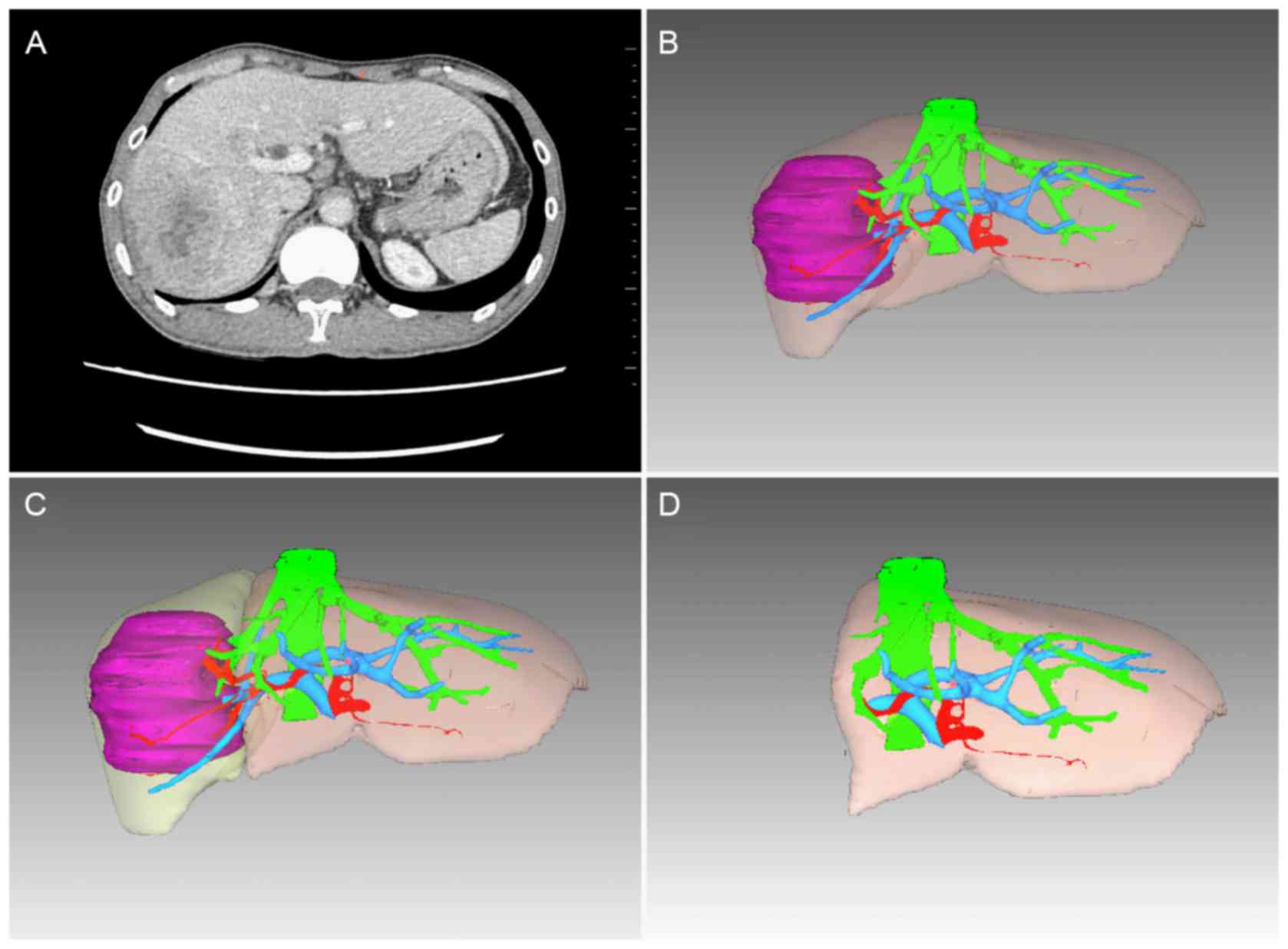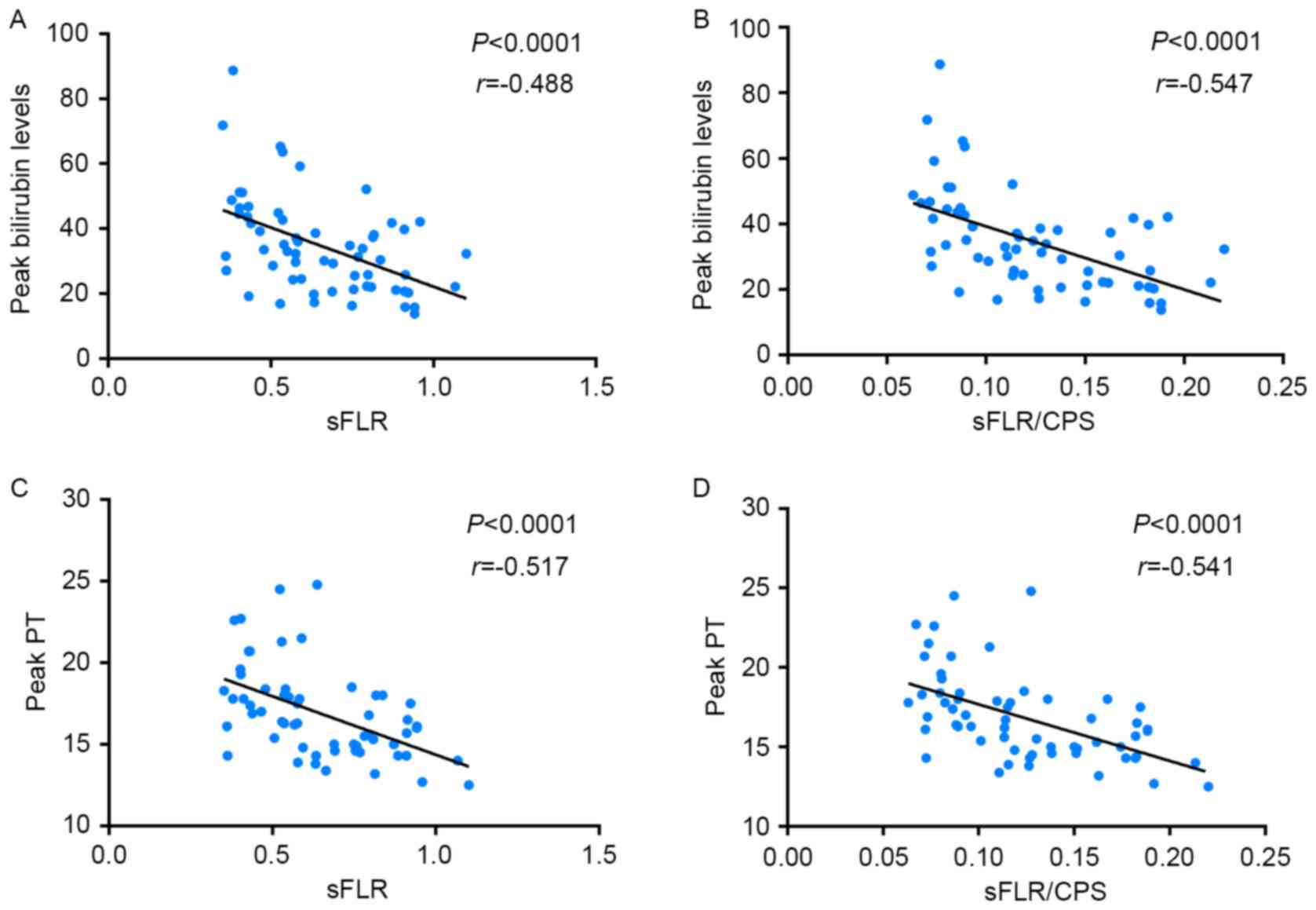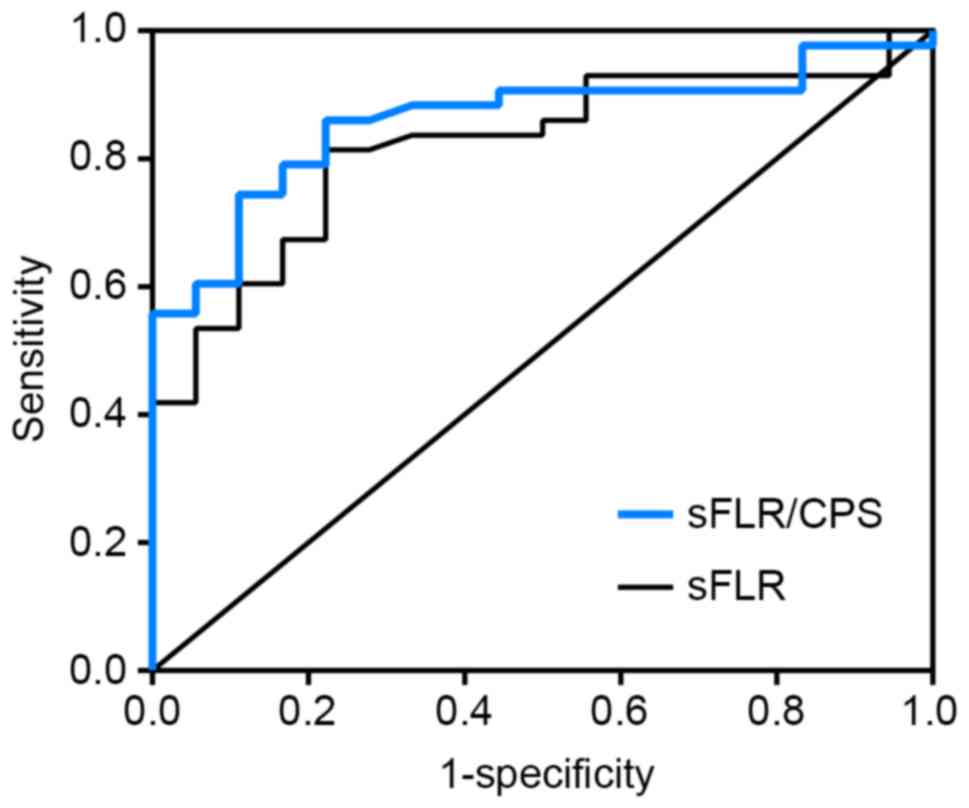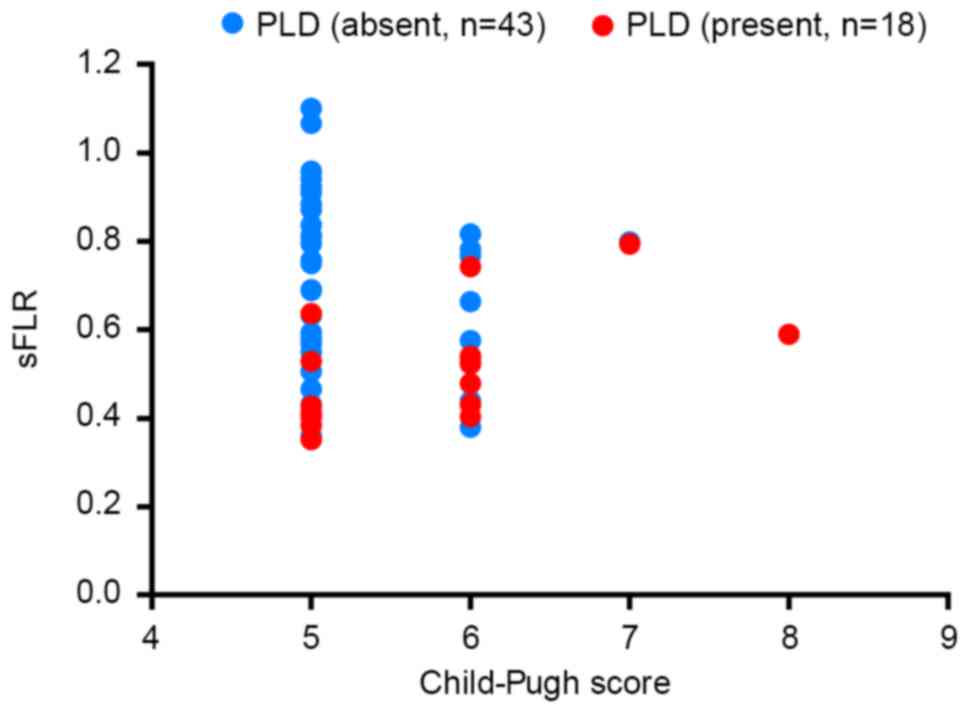|
1
|
Cauchy F, Soubrane O and Belghiti J: Liver
resection for HCC: Patient's selection and controversial scenarios.
Best Pract Res Clin Gastroenterol. 28:881–896. 2014. View Article : Google Scholar : PubMed/NCBI
|
|
2
|
Fonseca AL and Cha CH: Hepatocellular
carcinoma: A comprehensive overview of surgical therapy. J Surg
Oncol. 110:712–719. 2014. View Article : Google Scholar : PubMed/NCBI
|
|
3
|
Pugh RN, Murray-Lyon IM, Dawson JL,
Pietroni MC and Williams R: Transection of the oesophagus for
bleeding oesophageal varices. Br J Surg. 60:646–649. 1973.
View Article : Google Scholar : PubMed/NCBI
|
|
4
|
Garcea G, Ong SL and Maddern GJ:
Predicting liver failure following major hepatectomy. Dig Liver
Dis. 41:798–806. 2009. View Article : Google Scholar : PubMed/NCBI
|
|
5
|
Lim MC, Tan CH, Cai J, Zheng J and Kow AW:
CT volumetry of the liver: Where does it stand in clinical
practice? Clin Radiol. 69:887–895. 2014. View Article : Google Scholar : PubMed/NCBI
|
|
6
|
Wigmore SJ, Redhead DN, Yan XJ, Casey J,
Madhavan K, Dejong CH, Currie EJ and Garden OJ: Virtual hepatic
resection using three-dimensional reconstruction of helical
computed tomography angioportograms. Ann Surg. 233:221–226. 2001.
View Article : Google Scholar : PubMed/NCBI
|
|
7
|
Simpson AL, Geller DA, Hemming AW,
Jarnagin WR, Clements LW, D'Angelica MI, Dumpuri P, Gonen M,
Zendejas I, Miga MI and Stefansic JD: Liver planning software
accurately predicts postoperative liver volume and measures early
regeneration. J Am Coll Surg. 219:199–207. 2014. View Article : Google Scholar : PubMed/NCBI
|
|
8
|
Schindl MJ, Redhead DN, Fearon KC, Garden
OJ and Wigmore SJ: The value of residual liver volume as a
predictor of hepatic dysfunction and infection after major liver
resection. Gut. 54:289–296. 2005. View Article : Google Scholar : PubMed/NCBI
|
|
9
|
Clavien PA, Petrowsky H, DeOliveira ML and
Graf R: Strategies for safer liver surgery and partial liver
transplantation. N Engl J Med. 356:1545–1559. 2007. View Article : Google Scholar : PubMed/NCBI
|
|
10
|
Ribero D, Amisamo M, Bertuzzo F, Langella
S, Lo Tesoriere R, Ferrero A, Regge D and Capussotti L: Measured
versus estimated total liver volume to preoperatively assess the
adequacy of the future liver remnant: Which method should we use?
Ann Surg. 258:801–807. 2013. View Article : Google Scholar : PubMed/NCBI
|
|
11
|
Wagener G: Assessment of hepatic function,
operative candidacy, and medical management after liver resection
in the patient with underlying liver disease. Semin Liver Dis.
33:204–212. 2013.(In Danish, English). View Article : Google Scholar : PubMed/NCBI
|
|
12
|
Ribero D, Abdalla EK, Madoff DC, Donadon
M, Loyer EM and Vauthey JN: Portal vein embolization before major
hepatectomy and its effects on regeneration, resectability and
outcome. Br J Surg. 94:1386–1394. 2007. View Article : Google Scholar : PubMed/NCBI
|
|
13
|
Facciuto M, Contreras-Saldivar A, Singh
MK, Rocca JP, Taouli B, Oyfe I, LaPointe Rudow D, Gondolesi GE,
Schiano TD, Kim-Schluger L, et al: Right hepatectomy for living
donation: Role of remnant liver volume in predicting hepatic
dysfunction and complications. Surgery. 153:619–626. 2013.
View Article : Google Scholar : PubMed/NCBI
|
|
14
|
Urata K, Kawasaki S, Matsunami H,
Hashikura Y, Ikegami T, Ishizone S, Momose Y, Komiyama A and
Makuuchi M: Calculation of child and adult standard liver volume
for liver transplantation. Hepatology. 21:1317–1321. 1995.
View Article : Google Scholar : PubMed/NCBI
|
|
15
|
Pugh RN, Murray-Lyon IM, Dawson JL,
Pietroni MC and Williams R: Transection of the oesophagus for
bleeding oesophageal varices. Br J Surg. 60:646–649. 1973.
View Article : Google Scholar : PubMed/NCBI
|
|
16
|
Durand F and Valla D: Assessment of
prognosis of cirrhosis. Semin Liver Dis. 28:110–122. 2008.
View Article : Google Scholar : PubMed/NCBI
|
|
17
|
Johnson PJ, Berhane S, Kagebayashi C,
Satomura S, Teng M, Reeves HL, O'Beirne J, Fox R, Skowronska A,
Palmer D, et al: Assessment of liver function in patients with
hepatocellular carcinoma: A new evidence-based approach-the ALBI
grade. J Clin Oncol. 33:550–558. 2015. View Article : Google Scholar : PubMed/NCBI
|
|
18
|
Kaplan DE, Dai F, Aytaman A, Baytarian M,
Fox R, Hunt K, Knott A, Pedrosa M, Pocha C, Mehta R, et al:
Development and performance of an algorithm to estimate the
Child-Turcotte-Pugh Score from a national electronic healthcare
database. Clin Gastroenterol Hepatol. 13:2333–2341, e1-e6. 2015.
View Article : Google Scholar : PubMed/NCBI
|
|
19
|
Schneider PD: Preoperative assessment of
liver function. Surg Clin North Am. 84:355–373. 2004. View Article : Google Scholar : PubMed/NCBI
|
|
20
|
Hoekstra LT, de Graaf W, Nibourg GA, Heger
M, Bennink RJ, Stieger B and van Gulik TM: Physiological and
biochemical basis of clinical liver function tests: A review. Ann
Surg. 257:27–36. 2013. View Article : Google Scholar : PubMed/NCBI
|
|
21
|
Forner A, Llovet JM and Bruix J:
Hepatocellular carcinoma. Lancet. 379:1245–1255. 2012. View Article : Google Scholar : PubMed/NCBI
|
|
22
|
Cieslak KP, Runge JH, Heger M, Stoker J,
Bennink RJ and van Gulik TM: New perspectives in the assessment of
future remnant liver. Dig Surg. 31:255–268. 2014. View Article : Google Scholar : PubMed/NCBI
|
|
23
|
Hirashita T, Ohta M, Iwashita Y, Iwaki K,
Uchida H, Yada K, Matsumoto T and Kitano S: Risk factors of liver
failure after right-sided hepatectomy. Am J Surg. 206:374–379.
2013. View Article : Google Scholar : PubMed/NCBI
|
|
24
|
Truant S, Boleslawski E, Sergent G,
Leteurtre E, Duhamel A, Hebbar M and Pruvot FR: Liver function
following extended hepatectomy can be accurately predicted using
remnant liver volume to body weight ratio. World J Surg.
39:1193–1201. 2015. View Article : Google Scholar : PubMed/NCBI
|
|
25
|
Stockmann M, Lock JF, Riecke B, Heyne K,
Martus P, Fricke M, Lehmann S, Niehues SM, Schwabe M, Lemke AJ and
Neuhaus P: Prediction of postoperative outcome after hepatectomy
with a new beside test for maximal liver function capacity. Ann
Surg. 250:119–125. 2009. View Article : Google Scholar : PubMed/NCBI
|
|
26
|
Okabe H, Beppu T, Chikamoto A, Hayashi H,
Yoshida M, Masuda T, Imai K, Mima K, Nakagawa S, Kuroki H, et al:
Remnant liver volume-based predictors of postoperative liver
dysfunction after hepatectomy: Analysis of 625 consecutive patients
from a single institution. Int J Clin Oncol. 19:614–621. 2014.
View Article : Google Scholar : PubMed/NCBI
|













